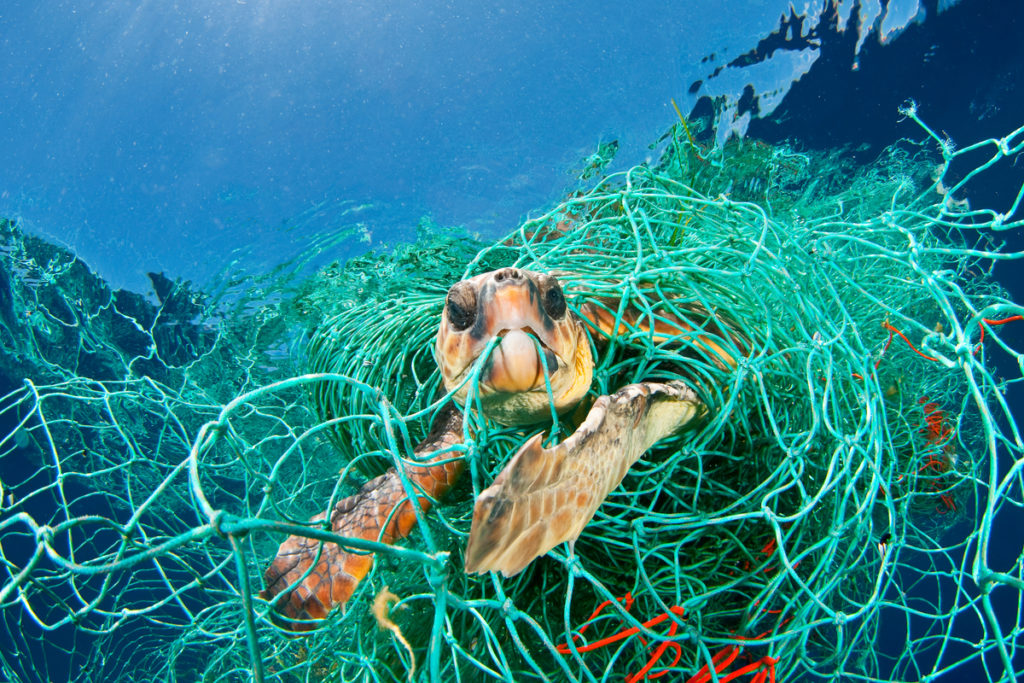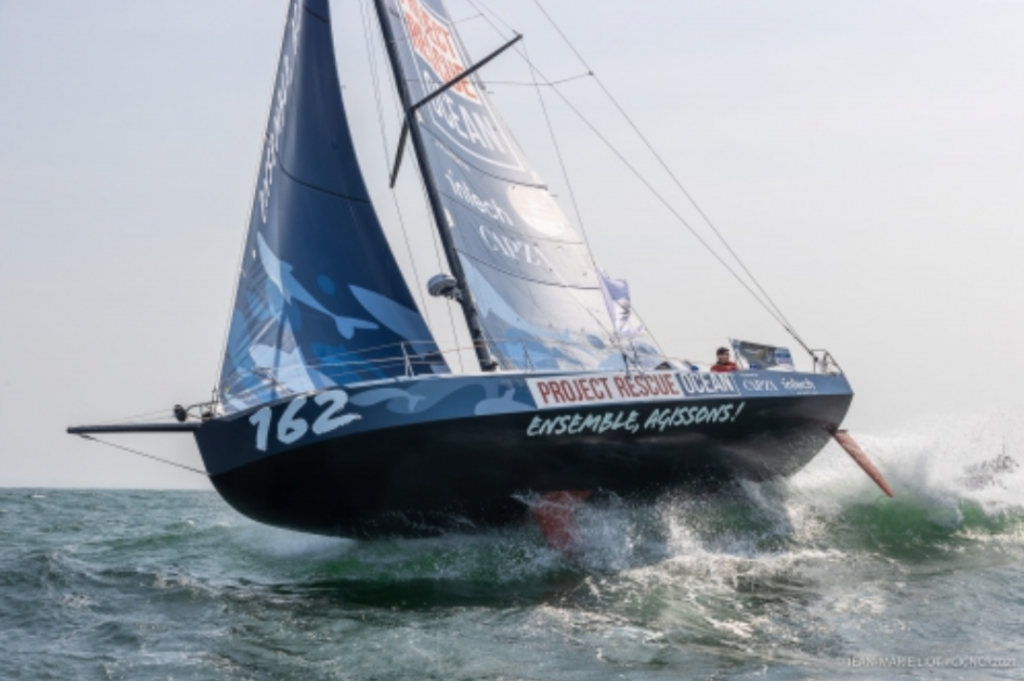And the importance of finding solutions

Each year, 11 million tons of plastic end up in the ocean, with an estimation of at least 10% of all marine clutter, being fishing equipment. Therefore, between 500 000 and 1 million tonnes of fishing gear is discarded every year, into the sea. Plastic is polluting every corner of our planet, including the ocean, and even though there is a growing awareness regarding this matter, this issue keeps on getting worse.
Water covers around 71% of the Earth’s surface, with the oceans detaining about 96.5% of all water. The ocean is of enormous importance, since it generates over 50% of the planet’s oxygen, absorbs 50 times more carbon dioxide than the atmosphere, and regulates the climate by transporting heat from the equator to the poles. It is imperative to protect this indispensable resource from further pollution.
But what is ghost gear and what is its impact?
The term ghost gear is applied to all types of fishing equipment -such as lines, nets, pots, traps, or fish aggregating devices – that were abandoned or lost in the ocean, beaches or in ports. In the same line, based on a recent study, it is estimated that, on a worldwide level, 29% of all fishing lines, 8.6% of traps and pots, and 5.7% of every fishing net used, are lost or discarded. Several fishing materials end up discarded or lost due to poor weather conditions, difficulty in accessing disposal or recycling facilities, lack of equipment maintenance, destructive or illegal fishing techniques, and many other reasons.
Even though the thrown or missing fishing materials are no longer actively operated by fishers or fisheries, these may still harm or even kill various marine species, such as sea turtles, dolphins, fishes, seals and others, by entanglement, ingestion or similar causes. According to a NRDC report, each year, more than 650 000 aquatic animals are killed or seriously injured by ghost fishing instruments. Furthermore, the capture of animals, either intentional, by using fishing fleets with extensive gillnets, or incidental, through lost gear or bycatch, is endagering some marine mammals, putting several animal populations on the verge of extinction. As an example, in the Gulf of California, Mexico, a species called vaquita porpoise is one of the most threatened sea animals, since it is estimated that there is only a total of 25 more in the world. Ghost nets highly contribute for the vaquita’s near extinction, because local fishermen operate with illicit nylon gillnets to capture a fish named totoaba, a seriously at risk species, that is sold illegally. And once these gillnets are discarded, vaquitas get entangled and drown.

Some measurements are already being administered, for example The United Nations Convention on the Law of the Sea (UNCLOS), Food and Agriculture Organization of the United Nations (FAO) Code of Conduct for Responsible Fisheries, Convention for Prevention of Marine Pollution (MARPOL), the regional fisheries management bodies (RFMOS), and other relevant instruments. UNCLOS legislatesall human activities in the marine environment, in order to ensure the protection and conservation of the ocean. FAO Code of Conduct lays out some legal foundation for responsible fishing activities. MARPOL is aconvention held by International Maritime Organization against sea pollution from boats. Finally, RFMOS is ajuridical system, for member states, to adopt measurements, with the objective of addressing the ghost gear matter. However, the current legislation on this problem is still immensely fragmented and ineffective.
It is extremely important to develop effective strategies that successfully battle the ghost gear pollution. The following proposed solutions can have an essential role in the reduction of the amount of abandoned fishing gear present in the seas:
Avoiding the loss of fishing gear is one of the top priorities. This includes methods like educating the fishers and crew members, voluntary regulations or limiting the manipulation of high-risk equipment in specific areas or periods of the year. It is also very pertinent marking all fishing instruments with the port letters and numbers (PLN)* of the vessel so it is possible to identify the owner. In addition, this task should preferably be executed during the manufacturing phase, as regional fishing authorities may not be capable to successfully carry out equipment marking schemes. Besides ownership marking, it is extremely important to also mark the position of the adrift fishing gear. Traditional gear marking procedures include flags, reflectors and buoys; while more recent techniques comprise satellite and electronic buoys or other electronic devices to remotely track the location. However, the modern procedures are still being evaluated in several fisheries to verify their utility. Finally, it is imperative that the fishing tools end-of-life disposal and recycling methods are seriously improved. Entities like tools manufacturers, companies, or even the government, should supply incentives, such as money or some sort of discounts, and accessible facilities for fishers to return end of life fishing materials. This way, these collected end of life materials, are able to be involved in a ‘circular economy’, by being refurbished or even recycled, in several innovative ways, like being transformed into plastic pellets, carpet tiles, art, skateboards and others. Nevertheless, some fishing materials will inescapably go missing, therefore endorsing in mitigation measures is also critical.
Furthermore, considering that plastic tools have long-term negative effects, it is crucial to remove and rescue as much abandoned equipment as possible. Even though this can be an expensive solution, especially if performed in deep-sea habitats, there are already some programmes for communicating and retrieving discarded fishing equipment, and “fish for litter” schemes – which compensates fishers for returning marine waste, including ghost gear. One example is Global Ghost Gear Initiative (GGGI), the very first global alliance founded with the aim of resolving the worldwide problem of discarded fishing equipment, by removing and recycling it, and by rescuing entangled animals.

End of season rescue projects are also efficient. However, a prompt retrieval of ghost fishing instruments is the best approach to avoid the problem and the many other damages caused by abandoned fishing gear. Although an immediate rescue of the materials demands for equipment on board especially designed to solve the problem, in all EU waters and in some other countries, fishermen must warn the authorities if a certain fishing tool is lost within 24 hours of the occurence. Yet, fishers operating illegal practices or from other countries without this rule, don’t obey and leave behind them untraceable path of discarded materials. When reporting lost gear is obligatory, the owner of retrieved lost gear suffers penalties, in case the fishery authorities were not informed. For example, in Washington’s State’s Salish Sea, communicating disappeared equipment is mandatory, and several fishers have been fined for not informing the loss of gear that was later recovered by removal crews, that traced the tool back to its owner. As an example, the Newly Lost Net Reporting, Response, and Retrieval Program, carried by Northwest Straits Foundation in Washington, provides a real-time phone and online reporting platform for lost fishing nets. The communications made to the system are acknowledged and answered within hours. Subsequently, response units are mobilized to discover and rescue newly lost fishing nets. Overall, the program has already removed over 70 newly lost gillnets, since its launch in 2012.

Another interesting solution to prevent ghost fishing is including biodegradable components, to guarantee that the gear decomposes faster. Degradable constituents are already used in some shellfish traps and fish aggregating devices**, although more research is needed to figure out if biodegradable nets and other fishing tools are as effective as the ones traditionally sold on the market. The production of biodegradable equipment is promising; however, it is still too underdeveloped to be carried out on a large scale, and it will only be possible to verify a more extensive execution of this sort of gear with some extra studies, in the next years, and possibly with the implementation of laws imposing the usage of biodegradable fishing materials, at a worlwide level.

*PLN is a code, printed on the side of the vessel, to identify the port at which a certain boat is listed to and its registration number.
** Fish Aggregating Devices (FAD) are floating items that are strategically designed and situated to attract pelagic fish.
Suggestions:
For further insights on the topic:
Watch Seaspiracy documentary on Netflix
Watch A Plastic Ocean documentary on Netflix
Donate or join the community of the Lisbon-based NGO GhostNetWork (Official Website: https://www.ghostnetwork.org/)
Get to know more about GGGI: https://www.ghostgear.org/about-us
References:
Hadley, S., (23/11/2020). Up to a Million Tons of Ghost Fishing Nets Enter the Oceans Each Year- Study. Available at: https://earth.org/up-to-a-million-tons-of-ghost-fishing-nets-enter-the-oceans-each-year-study/
WWF (10/2020). Stop Ghost Gear; The Most Deadly Form Of Marine Plastic Debris. Available at: https://europe.nxtbook.com/nxteu/wwfintl/ghost_gear_report/index.php#/p/1
Oceanographic (N/D). Greenpeace report concludes that discarded fishing gear is ocean’s greatest plastic polluter. Available at: https://www.oceanographicmagazine.com/news/ghost-gear-greenpeace/
Greenpeace International (06/11/2019). Ghost Gear: The Abandoned Fishing Nets Haunting Our Oceans. Available at: https://www.greenpeace.org/international/publication/25438/ghost-gear/
USGS (N/D). How Much Water is There on Earth? Available at: https://www.usgs.gov/special-topic/water-science-school/science/how-much-water-there-earth?qt-science_center_objects=0#qt-science_center_objects
NOAA (26/02/2021). Why Should We Care About The Ocean? Available at: https://oceanservice.noaa.gov/facts/why-care-about-ocean.html
Olive Ridley Project (N/D). What Are Ghost Nets? Available at:
Plastic Soup Foundation (N/D). Ghost Nets. Available at: https://www.plasticsoupfoundation.org/en/plastic-problem/plastic-environment/ghost-nets/
Smith, Z., Gilroy, M., Eisenson, M., Schnettler, E., & Stefanski, S. (01/2014). Net Loss: The Killing of Marine Mammals in Foreign Fisheries. Available at: https://www.nrdc.org/sites/default/files/mammals-foreign-fisheries-report.pdf
WSPA (N/D). Ghosts Beneath The Waves. Available at: https://www.worldanimalprotection.us/sites/default/files/media/us_files/ghosts_beneath_the_waves.pdf
Giskes, I., (10/10/2017). The Ghosts In Our Ocean: Lost And Abandoned Fishing Gear Is Killing Thousands Of Marine Animals Every Year. Available at: https://impakter.com/the-ghosts-in-our-ocean-lost-and-abandoned-fishing-gear-is-killing-thousands-of-marine-animals-every-year/
Ocean Conservancy, GGGI, WWF (N/D). Effective Ghost Gear Solutions; Learning From What Works. Available at: https://static1.squarespace.com/static/5b987b8689c172e29293593f/t/5faaefc94ea65d7df575637b/1605038112701/GGGI-WWF+Solutions+Report+-+FINAL.pdf
Brixham Fish Market (N/D). Available at: https://brixhamfishmarket.co.uk/port-letters-numbers/
NOAA (30/11/2017). Fishing Gear: Fish Aggregating Devices. Available at: https://www.fisheries.noaa.gov/national/bycatch/fishing-gear-fish-aggregating-devices

